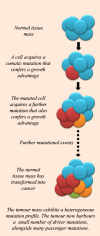Finding cancer driver mutations in the era of big data research
- PMID: 29611034
- PMCID: PMC6381364
- DOI: 10.1007/s12551-018-0415-6
Finding cancer driver mutations in the era of big data research
Abstract
In the last decade, the costs of genome sequencing have decreased considerably. The commencement of large-scale cancer sequencing projects has enabled cancer genomics to join the big data revolution. One of the challenges still facing cancer genomics research is determining which are the driver mutations in an individual cancer, as these contribute only a small subset of the overall mutation profile of a tumour. Focusing primarily on somatic single nucleotide mutations in this review, we consider both coding and non-coding driver mutations, and discuss how such mutations might be identified from cancer sequencing datasets. We describe some of the tools and database that are available for the annotation of somatic variants and the identification of cancer driver genes. We also address the use of genome-wide variation in mutation load to establish background mutation rates from which to identify driver mutations under positive selection. Finally, we describe the ways in which mutational signatures can act as clues for the identification of cancer drivers, as these mutations may cause, or arise from, certain mutational processes. By defining the molecular changes responsible for driving cancer development, new cancer treatment strategies may be developed or novel preventative measures proposed.
Keywords: Big data; Cancer; Cancer genomics; Driver mutation; Genome; Mutational signatures; Selection; Sequencing; Somatic.
Conflict of interest statement
Conflicts of interest
Rebecca C. Poulos declares that she has no conflict of interest. Jason W.H. Wong declares that he has no conflict of interest.
Ethical approval
This article does not contain any studies with human participants or animals performed by any of the authors.
Figures


References
Publication types
Grants and funding
LinkOut - more resources
Full Text Sources
Other Literature Sources

